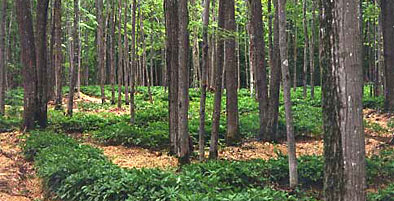Yes. You would need to confirm that conditions in your shelterbelt agree with growing conditions for the plant(s) you want to grow. Ginseng and ramps, best grown in moist hardwood forests, may not be good choices in a Midwest shelterbelt, especially a new planting without deep shade or if the area does not have rich soils high in organic matter. If you are in a forest type (rich, moist and high in organic matter) where you know ginseng grows (or once grew) you may have a good bet to include it in a mature shelterbelt. You could also consider other medicinal/edible herbs, or some plants to provide products to the floral industry (willows or colored dogwood stems also known as “woody florals” – google the search term “growing woody florals” to find up-to-date information), berries or other small fruits that may be more suited to your shade, soil and moisture conditions. You may be able to grow some plants early on while there would be lots of sun then put in others between the trees as they mature. A good source of information that would be more specific to your question would be the University of Missouri Center for Agroforesty (www.centerforagroforestry.org) or the USDA National Agroforestry Center (http://www.unl.edu/nac/) or specifically on shelterbelts/windbreaks and floral products out of University of Nebraska (e.g. http://arboretum.unl.edu/poppages/clshelterbelts.htm). For a good overview on the topic of forest farming, consider watching a short (15 minute) video overview of forest farming (http://www.youtube.com/watch?v=o_77cBnwUNo). A very good book to read on this topic is: Person, W.S. and J.M. Davis. 2005. Growing and marketing ginseng, goldenseal and other woodland medicinals. Bright Mountain Books, Inc. Fairview, NC. 466 p.
